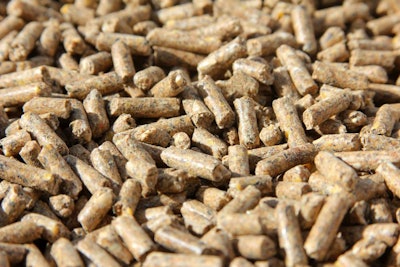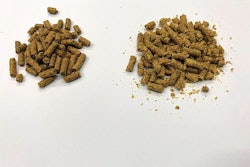
Extreme pelleting conditions can have harsh effects on certain feed additives
Pelleting is a combination of five factors: temperature, heat, moisture, pressure and time.
Typically, a complete feed is conditioned under heat and humidity for up to 20 minutes before being pressed at extreme speed through die openings, where high friction further elevates external temperature. The higher we go with the above values, the better a pellet is produced, in terms of physical characteristics such as durability, pellet length and even appearance.
High temperatures, up to 90 degrees Celsius, are often applied to reduce the pathogenic load for selected feeds, although the usual pelleting temperature is around 60 degrees Celsius.
With pelleting, it is accepted that the digestibility of specific nutrients is improved by up to 5-15%. Extreme pelleting conditions, however, can have the opposite result. The most notable example here is the destruction of free amino acids, especially lysine when combined with free reducing sugars – the famous browning reaction.
With so many additives used routinely in most feeds, we need to consider their response to pelleting conditions very carefully. Here, we present six interesting examples.
1. Probiotics
According to many experts, the first commercial applications of probiotics failed because the bacteria strains selected simply did not survive the pelleting process. The advent of Bacillus strains has resolved this problem as their spores are resistant against many extreme conditions. But, when it comes to lactic acid-producing bacteria strains – the other half of the probiotic market – pelleting can still be the source of concern as these are not as resistant at high temperatures. Specific products should have an upper pelleting temperature limit indicated by their supplier.
2. Enzymes
Enzymes are proteins, and proteins are sensitive to heat. Once they lose their natural state – denaturation – they lose many of their fundamental properties. This is especially true for commercial enzymes that become inactive once overheated. Again, significant improvements have been accomplished in selecting enzymes that are more resistant (but not indestructible). For example, a phytase enzyme product will indicate at which conditions it starts to lose its potency. Feed manufacturers can then adjust pelleting conditions or use more of the same enzyme. Suppliers often provide retention charts that show the reaction of their products to adverse pelleting conditions.
3. Minerals
Inorganic minerals cannot be easily destructed, but in a moist environment, they can start interacting with other minerals and even some organic compounds, always given enough time. The prime example here is the negative interaction between some minerals and vitamins. Using an organic form of a mineral usually prevents such an undesirable interaction. Still, the organic part may be damaged by the pelleting process, thus negating any benefits the organic combination may have conferred to the animal.
4. Vitamins
Some vitamins are virtually indestructible, whereas others are susceptible to heat. For example, vitamin C is almost completely wiped out during any thermal processing. This is why this vitamin is nowadays used only with a thermal-resistant coating. Each vitamin has its own reaction chart to pelleting temperatures, and the vitamin premix should be adjusted accordingly. Just adding more of the same premix is simply a waste of those vitamins that do not require such safety margins.
5. Phytogenics
This is new territory, but we can easily refer to the volatile nature of some essential oils that comprise some, but not all, of the compounds used in these commercial products. With enough heat and moisture, essential oils – including some aroma-heavy flavors – will evaporate quickly during pelleting and the drying process. Some products are offered with a protective cover. But questions exist on whether such protection also limits the range of their actions.
6. Amino acids
Amino acids participate in the Maillard reaction, as mentioned above. Feed-grade free lysine is the most sensitive because it has two interaction opportunities. Feeds always contain some soluble sugars that, with enough moisture, can yield reducing sugars such as glucose. Sucrose and lactose, when added as a sweetener or energy source, respectively, can be the source of such reducing sugars as they are easily hydrolyzed during mash conditioning. The main issue with the Maillard reaction is that it is an auto-feedback mechanism. Once it starts, it does not stop. Thus, we can only reduce its speed. Hence the recommendations for storing feed in a cool, dry, and dark place.
Practical advice
If your feed mill produces pelleted feed, the first order of business is to determine the exact value of the five parameters mentioned in this article. The more adverse the pelleting conditions, the more attention needs to be paid to the fate of any and all ingredients, and primarily to feed additives. We should not merely assume that suppliers have already taken care of this aspect. We should discuss with them our specific pelleting requirements and demand a retention/reaction chart for their product. In the end, we may need to add more of the desired additive, or switch to a more stable one, or just abandon one additive class for another that does a similar job.















